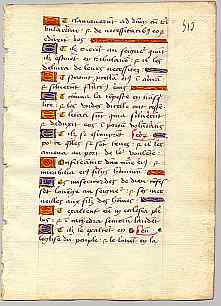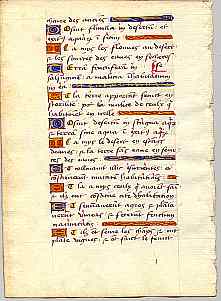

This is an interesting sample, not least because of some mystery as to its origins and purpose, and because there are some little conundrums in its production values. It is evidently a leaf from a psalter in which the text is entered verse by verse, first in Latin, then in French. There appear to be some accents or pronunciation guides over words in the Latin text. This is not a huge and fancy volume for placing on a church lectern, or for impressing the visitors, but it does have some elegant features. It is quite small, the page size being approximately 14 x 10 cm, and the written area around 11 x 6 cm.

The script is a late Gothic cursive, which may be ascribed a complex name if that is your inclination, but such scripts were becoming so hybridised by this time that it hardly seems worth the trouble. Suffice to say that while it is fully cursive, flowing, and even somewhat casual in some letter forms, it still comes out very neat and legible, which is more than can be said for many 16th century hands. Each verse begins with a tiny but elegant illuminated capital and there are intricate little line fillers, so somebody has lavished some meticuluous attention on it, even though the script is not a formal book hand.
I would be guessing that this is a text for study and learning, enabling some cleric whose Latin may not have been so fluent as that of his learned predecessors of earlier centuries, to learn his Latin psalter, and furthermore, to be able to read it aloud with some degree of accuracy, understanding and conviction. The cheaper medium of paper and the relatively rapidly written script suggest that it is a personal item rather than a display volume, while the intricate detailing suggests that it was a valued possession.
The text of this page is Psalm 106 (107 in a modern Bible) verses 28 through 37.
| overview | text | alphabet | abbreviations | exercises | transcript | translation |
If you are looking at this page without frames, there is more information about medieval writing to be found by going to the home page (framed) or the site map (no frames).